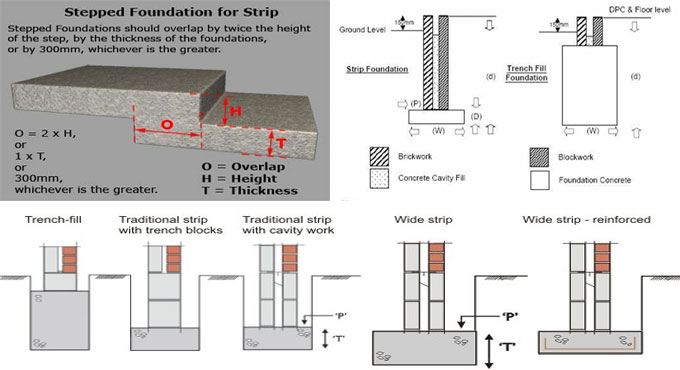
Details of thickness requirements of strip foundation
Strip foundations are made of a continuous strip, normally with concrete. These are primarily developed under load bearing walls. This continuous strip can be used as a level base on which the wall is constructed and contains a width essential to extend the load on the foundations to an area of subsoil likely to support the load devoid of improper compaction.
The width of a concrete strip foundation is based on the bearing strength of the subsoil as well as the load on the foundations. The width of the foundation for the similar load will be reduced if the bearing strength of the subsoil is greater.
Various factors like losing condition, types of soil, and depth of foundation are mainly responsible to influence the thickness of strip foundation. Given below, the details of the thickness of strip foundation on the basis of load conditions and depth of foundation.
Thickness of strip foundation bearing light loads
Generally, the thickness of strip foundation is equivalent to the protrusion from the face of footing or the wall but it should not be under 150mm. This lowest thickness is enforced to ensure that the strip foundation contains sufficient hardness and as a result capable of bonding feeble pockets in soil.
Besides, it resists longitudinal force formed with thermal contraction and expansion and progressions of moisture of footing wall. If the type of soil underside foundation is clay, then swelling of clay should be large and employ pressure on the foundation. Therefore, it is essential to enforce minimum limit on the strip foundation.
Thickness of strip foundation sustaining heavy loads
If strip foundation has the ability to sustain large loads, then the thickness of the foundation is managed by its strength with the purpose of resisting shear and bending moments which can lead to collapsing of foundation projection.
When reinforcements are not implanted into the strip foundation, then bedding failure of strip foundation would manage its thickness.
The concrete thickness should be sufficient to get rid of the bending failure. The stepped or sloped transition can be employed to the specified thickness from the face of the wall to the bottom width.
Often, strip foundation is designed conventionally by selecting a thickness that resists the formation of tension on the base of the strip. Such thickness is normally equivalent to two times the projection of the strip.
Conversely, a 45 degree distribution of loads at the base of strip foundation is provided. Based on this load distribution, a little amount of tension stress at the base of foundation is tolerable but its magnitude is unknown.


